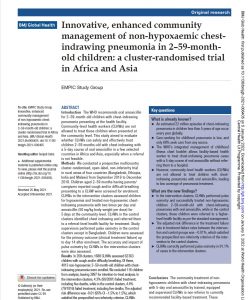
Introduction
The WHO recommends oral amoxicillin for 2–59-month-old children with chest-indrawing pneumonia presenting at the health facility. Community-level health workers (CLHWs) are not allowed to treat these children when presented at the community level. This study aimed to evaluate whether CLHWs can safely and effectively treat children 2–59 months-old with chest indrawing with a 5-day course of oral amoxicillin in a few selected countries in Africa and Asia, especially when a referral is not feasible.
Methods
We conducted a prospective multicountry cluster-randomised, open-label, non-inferiority trial in rural areas of four countries (Bangladesh, Ethiopia, India and Malawi) from September 2016 to December 2018. Children aged 2–59 months having parents/caregivers reported cough and/or difficult breathing presenting to a CLHW were screened for enrolment. CLHWs in the intervention clusters assessed children for hypoxaemia and treated non-hypoxaemic chest-indrawing pneumonia with two times per day oral amoxicillin (50 mg/kg body weight per dose) for 5 days at the community level. CLHWs in the control clusters identified chest indrawing and referred them to a referral-level health facility for treatment. Study supervisors performed pulse oximetry in the control clusters except in Bangladesh. Children were assessed for the primary outcome (clinical treatment failure) up to day 14 after enrolment. The accuracy and impact of pulse oximetry by CLHWs in the intervention clusters were also assessed.
Results
In 208 clusters, 1688 CLHWs assessed 62 363 children with cough and/or difficulty breathing. Of these, 4013 non-hypoxaemic 2–59-month-old children with chest-indrawing pneumonia were enrolled. We excluded 116 children from analysis, leaving 3897 for intention-to-treat analysis. In the intervention clusters, 4.3% (90/2081) failed treatment, including five deaths, while in the control clusters, 4.4% (79/1816) failed treatment, including five deaths. The adjusted risk difference was -0.01 (95% CI −1.5% to 1.5%), which satisfied the prespecified non-inferiority criterion. CLHWs correctly performed pulse oximetry in 91.1% (2001/2196) of cases in the intervention clusters.